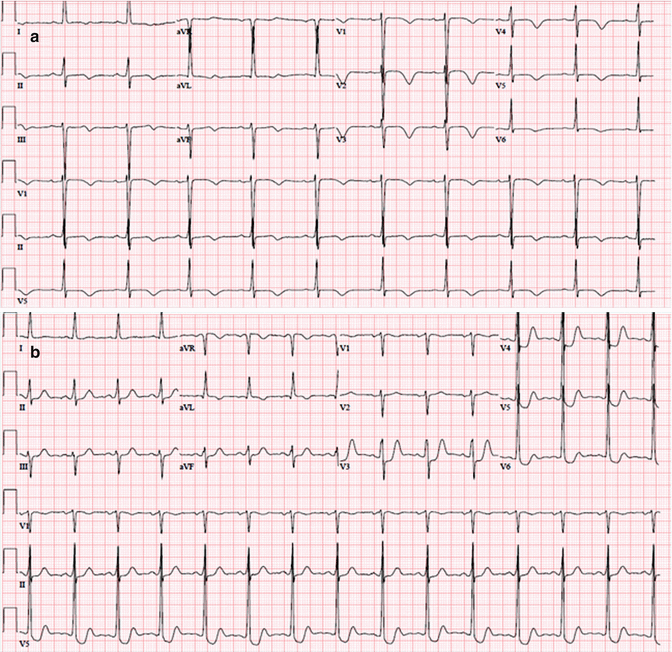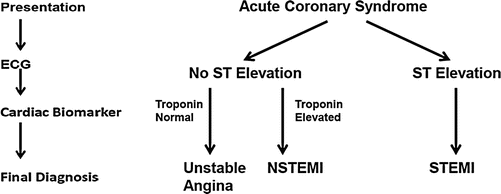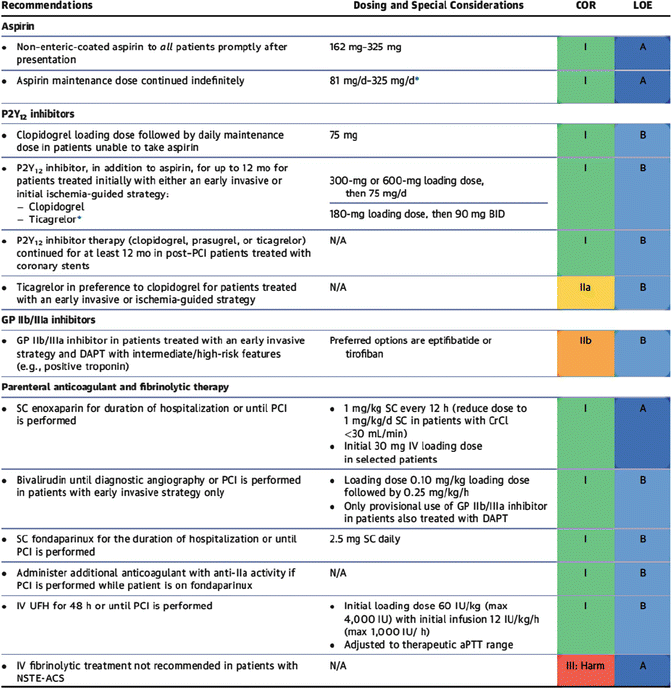Fig. 12.1
EKG demonstrating inferior and posterior ST-segment elevations in a patient with STEMI
Question
What approach should guide this patient’s further management?
Answer
All patients with acute coronary syndrome with ST-segment elevation myocardial infarction (STEMI) should undergo emergent reperfusion therapy with primary percutaneous coronary intervention (PCI) or fibrinolysis.
This patient underwent emergent invasive coronary angiography, which revealed a discrete 90 % lesion in the proximal right coronary artery. He was treated by primary PCI with drug-eluting stent placement. The patient had an uneventful hospital course and was discharged on aspirin, ticagrelor, metoprolol, atorvastatin and lisinopril.
Principles of Management
Diagnosis
Acute coronary syndrome (ACS) refers to spectrum of conditions associated with acute myocardial ischemia and/or infarction that are most frequently due to sudden decrease in coronary blood flow from an atherothrombotic obstruction. The first step in the management of patients with ACS is prompt recognition, as beneficial effects of therapy are greater when started soon after presentation, and steadily decline in the hours that follow the first signs of myocardial injury. The most common symptom that prompts the diagnostic evaluation of ACS is chest discomfort. Classification of patients presenting with ACS is based on electrocardiogram. Patients with persistent ST-segment elevation are deemed as having ST-segment elevation ACS (STE-ACS) due to the presumed acute complete coronary occlusion and are candidates for immediate reperfusion therapy with either primary angioplasty or fibrinolysis. Absence of ST-segment elevation in a patient with ACS suggests non-ST segment elevation ACS (NSTE-ACS) (Fig. 12.2), which is further classified on the basis of biomarkers of myocardial necrosis. In an appropriate clinical setting, if the biomarkers are elevated the patient is classified as having a non-ST segment elevation MI (NSTEMI), otherwise, without elevated biomarkers; the patient should be diagnosed with unstable angina (UA) (Fig. 12.3). The primary diagnostic biomarkers of ACS are Troponin T and Troponin I. With contemporary troponin assays, CK-MB and myoglobin are less useful for diagnosis of ACS. However, patients with end-stage-renal disease and no clinical evidence of ACS could have chronically elevated troponins. With conventional assays, this is more common with cardiac troponin T than cardiac troponin I. In the diagnosis of ACS, cardiac troponin values must manifest an acute pattern consistent with the ischemic symptoms and electrocardiographic changes.



Fig. 12.2
EKG demonstrating diffuse T wave inversion (a) and ST depression in patients with NSTE-ACS (b)

Fig. 12.3
Acute coronary syndromes
ECG abnormalities and elevated biomarkers in isolation are insufficient to make the diagnosis of ACS, and must be interpreted in an appropriate clinical context. MI must be discriminated from other acute and chronic causes of myocardial injury, such as pulmonary embolism, severe sepsis, and end-stage renal disease, which occur commonly in the intensive care setting. Moreover, MI may be further classified into those caused by acute atherothrombotic coronary events (Type 1 MI) and those caused by supply–demand mismatch, as is seen in instances of myocardial injury with necrosis where a condition other than CAD contributes to an imbalance between oxygen demand and supply, e.g., coronary endothelial dysfunction, coronary artery spasm, coronary embolism, tachy-/bradyarrhythmias, anemia, respiratory failure, hypotension, and hypertension with or without left ventricular hypertrophy (Type 2 MI). We typically reserve the term acute coronary syndrome for patients with acute atherothrombosis (Type 1 MI).
Once the diagnosis of STEMI, NSTEMI or unstable angina is made, the acute management of the patient involves achievement of several goals followed by initiation of therapy that may improve the long-term prognosis.
Initial Assessment and Early Risk Stratification
Clinical assessment of a patient with ACS should begin as soon as the patient arrives in the emergency department and continues in hospital wards or the intensive care units. Initial assessment includes evaluation for hemodynamic stability and early risk stratification. A 12-lead ECG should be obtained in all patients with suspected ACS within 10 min after first medical contact and immediately read by an experienced physician.
Early risk stratification in patients with ACS is critical to identify those at higher risk of adverse cardiac events and may benefit from a more aggressive therapeutic approach [1–4]. Analyses from several large clinical trials have established a number of predictors of adverse outcomes among patients with STEMI, NSTEMI and unstable angina. However, with need for emergent reperfusion therapy through primary angioplasty or fibrinolysis in patients with STEMI, their clinical utility in early therapeutic decision-making is less relevant to STEMI patients. Some of the early predictors of poor outcome from STEMI include age, tachycardia, low blood pressure, Killip class (Table 12.1), time to reperfusion, diabetes mellitus, anterior infarct location, smoking status, renal function and elevated biomarker. Examples of validated risk score include the TIMI risk score for STEMI [5] and NSTEMI/UA [6] and the GRACE Risk Score [7].
Table 12.1
Killip classification of acute myocardial infarction
Class I | No evidence of heart failure |
Class II | Findings consistent with mild to moderate heart failure (S3 gallop, lung rales less than one-half way up the posterior lung fields or jugular venous distension) |
Class III | Overt pulmonary edema |
Class IV | Cardiogenic shock |
Initial Medical Therapy
Patients with STEMI, NSTEMI and unstable angina are treated with similar medical regimens, with the exception of fibrinolysis, which should be limited to STEMI patients. The timing of initiation of medication may vary between STEMI and NSTEMI/UA.
Anti-ischemic Therapy
Oxygen
Supplemental oxygen should be administered to patients with ACS with arterial oxygen saturation less than 90 %, respiratory distress, cyanosis or other higher risk features of hypoxemia. The value of supplemental oxygen therapy in ACS patients without hypoxia is unclear, as several studies have suggested that supplemental oxygen in normoxic patients with ACS may increase myocardial injury and mortality [8, 9].
Nitrates
Patients with continuing chest pain should be initially treated with sublingual nitroglycerin (0.3–0.4 mg) every 5 min for up to three doses. If ischemic pain persists, intravenous nitroglycerin should be considered if not contraindicated. Nitrates should not be administered to patients with severe aortic stenosis, or patients who received a phosphodiesterase-5 inhibitor, and should be cautiously used in patients with suspected right ventricular infarction due to their dependence on pre-load [10].
Morphine
In patients with ACS, it is reasonable to administer intravenous morphine for analgesia if the patient has continued chest pain despite maximally tolerated anti-ischemic medications. NSAIDS (except aspirin) in patients with ACS are associated with increased risk of major adverse cardiac events; therefore, its use in ACS patients is not recommended [11].
Beta-Adrenergic Blockers
In patients with ACS beta-blockers decrease myocardial ischemia and frequency of ventricular arrhythmias and increase long term survival [12]. Oral beta-blocker therapy should be initiated within the first 24 h in patients who do not have signs of HF, evidence of low-output state, increased risk for cardiogenic shock (>70 years of age, systolic blood pressure <120 mmHg, heart rate >110 bpm or heart rate <60 bpm) or other contraindications to beta-blockade (e.g., PR interval >0.24 s, second- or third-degree heart block without a cardiac pacemaker, active asthma, or documented reactive airway disease). Beta-blockers should be titrated to decrease the heart rate to less than 70/min while maintaining a systolic blood pressure above 120 mmHg. A non-dihydropyridine calcium channel blocker (CCB) (e.g., verapamil or diltiazem) should be considered in patients in whom beta-blockers are contraindicated.
Statin therapy
High-intensity statin (atorvastatin 80 mg or rosuvastatin 40 mg) should be started or continued in all patients with ACS without contraindication. Statins in ACS reduces cardiac deaths, recurrent MI, need for repeat revascularization, and stroke [13].
Anti-thrombotic Therapy
All patients with ACS, in the absence of contraindications, should receive aspirin, a second antiplatelet agent, and an anticoagulant. The AHA/ACC guidelines for anti-thrombotic medical management of NSTE-ACS is provided in Fig. 12.4.


Fig. 12.4
AHA/ACC recommendations for initial anti-thrombotic therapy in NSTE-ACS (From Amsterdam et al. [2]. Reprinted with permission from Elsevier Limited)
Antiplatelet Therapy
In the absence of an absolute contraindication, antiplatelet therapy with aspirin and a P2Y12 inhibitor is indicated in all patients with ACS.
Aspirin
Uncoated aspirin (325 mg) should be administered to all patients with ACS without contraindications as early as possible on presentation, and a maintenance dose of aspirin (81–162 mg daily) should be continued indefinitely.
P2Y12 receptor inhibitors
P2Y12 receptor inhibitors are administered to patients with ACS according to the type of presentation and how they are treated:
STEMI patients
Primary PCI – In patients with STEMI treated with primary PCI, a loading dose of a P2Y12 receptor inhibitor should be given as early as possible (clopidogrel [600 mg followed by 75 mg/day], ticagrelor [180 mg followed by 90 mg BID], or prasugrel [60 mg followed by 10 mg/day]). Ticagrelor as compared with clopidogrel significantly reduces rate of death from vascular causes, MI, or stroke [14].
Fibrinolysis – In patients with STEMI treated with fibrinolysis, clopidogrel [300 mg loading dose for age < =75 year old or 75 mg for >75 year old, followed by 75 mg/day] should be administered at the time of presentation.
NSTEMI/UA patients
PCI – In patients with NSTEMI/UA undergoing PCI with stenting should receive a loading dose of a P2Y12 inhibitor at the time of the procedure (clopidogrel [600 mg followed by 75 mg/day], ticagrelor [180 mg followed by 90 mg BID], or prasugrel [60 mg followed by 10 mg/day]). Ticagrelor and Prasugrel, as compared with clopidogrel, significantly reduce rate of death from vascular causes, MI, or stroke [14, 15].
Stay updated, free articles. Join our Telegram channel

Full access? Get Clinical Tree







